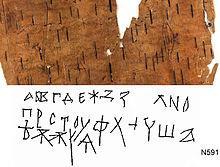
3 minute read
Russian
The Origins of the Cyrillic Alphabet
The Cyrillic alphabet is one of the oldest, and one of the most widespread alphabets in the world, and is used in more than 50 languages, the main ones being Russian, Serbian, Ukrainian and Bulgarian. It is the third official script of the European Union, following the Latin and Greek scripts.
Advertisement
The Glagolitic alphabet- the earliest form of the Cyrillic alphabet - was first founded in the 9th century by St. Cyril and Methodius of Greece who were spreading Christianity to the Slavs. In order to make it easier to communicate with them, Cyril expanded the Greek alphabet and added newly invented letters to represent sounds that were not used in Greek, thus, forming 24 Greek letters with 19 Glagolitic ones. His students in the First Bulgarian Empire then standardised the early Cyrillic alphabet and made the alphabet official.
Despite the similarities in writing, the Russian and Greek languages themselves are very different, where syntax and grammar are in no way related. Greek is a Mediterranean Hellenic language, while Russian is a Baltic-Slavic language
Since the creation of the Cyrillic alphabet, there have been numerous reforms. In Russia, the first reformer of the Cyrillic was printer and publisher Ivan Fyodorov. He eliminated the letters Е and С and many forms of the letter О. At the end of 18th century the Russian writer and historian Nikolay Karamzin suggested to introduce the letter Ё. Letters Э and Й were also officially added to the alphabet in this century. The Cyrillic alphabet achieved its current form in 1708 during the reign of Peter the Great. He introduced lower case characters (all letters were written with capital letters before this) and mandated the use of westernized letter forms, making the modern Cyrillic similar to the modern Latin font.
In Russia today, the Old Slavic language is still sometimes used for religious services. The modern Russian alphabet differs from its forefather dramatically, and only experts will be able to tell how the letters of the original Cyrillic alphabet looked like and read texts using it.
The Cyrillic Alphabet on a Birch Bark Document from ancient Novgorod (Russia) Dated to 1025-1050 AD
Diora Juraboeva
Del origen, al romance; la historia de la lengua española
Es interesante pensar en como el español que ha ido evolucionando a través de las distintas etapas de la historia. El español que escuchamos y hablamos hoy es muy diferente puesto que el español tal y como lo entendemos actualmente ha pasado por miles de años de desarrollo e influencia cultural. El español con más de 330 millones de hablantes repartidos en más de 20 países es la lengua "Romance" más hablada, por encima del portugués, el francés y el italiano, por citar algunos. Los historiadores creen originariamente hubo una gran familia a la que han llamado “Protoindoeuropa" y cuyas lenguas fueron habladas hasta el 3,400 AEC. Estas lenguas formaron la base de muchas de las lenguas románticas. A medida que las personas que hablaban estas lenguas se desplazaban, iban extendiendo su lengua por Europa y Asia, así se propagaron lenguas como el griego, el armenio, el baluo-eslavo y el albanés. Se cree que el español empezó a desarrollarse en la Península Ibérica (donde se encuentran España y Portugal) cuando los romanos se instalaron en la zona hablando una forma más ruda de latín, el latín vulgar. Esta lengua se mezcló con otras lenguas que se hablaban en esa misma zona. Alrededor del siglo XI se formó el dialecto castellano en el Norte de España. Se ha comprobado que ahí está localizado el punto inicial donde podemos ver los comienzos del español tal y como se habla hoy. Sin embargo, es importante señalar que el español también se habla en Sudamérica. Fué Cristóbal Colón quien comenzó a difundir el idioma a lugares como las Islas Bahamas, Trinidad y América del Sur.
Con el paso del tiempo, los sonidos del español latinoamericano se han vuelto bastante diferentes a los del español peninsular Hasta el día de hoy, hay diferencias de pronunciación que hacen que los dialectos suenen diferentes. Además, hay diferencias de vocabulario, por ejemplo, en España alguien conduce “un coche” (a car) mientras que en otros lugares se conduce “un carro”.
El español es el resultado de muchas décadas de evolución lingüística y sus orígenes muestran que las lenguas no se forman aisladamente, ya que ahora se hablan dialectos más matizados a nivel mundial.











